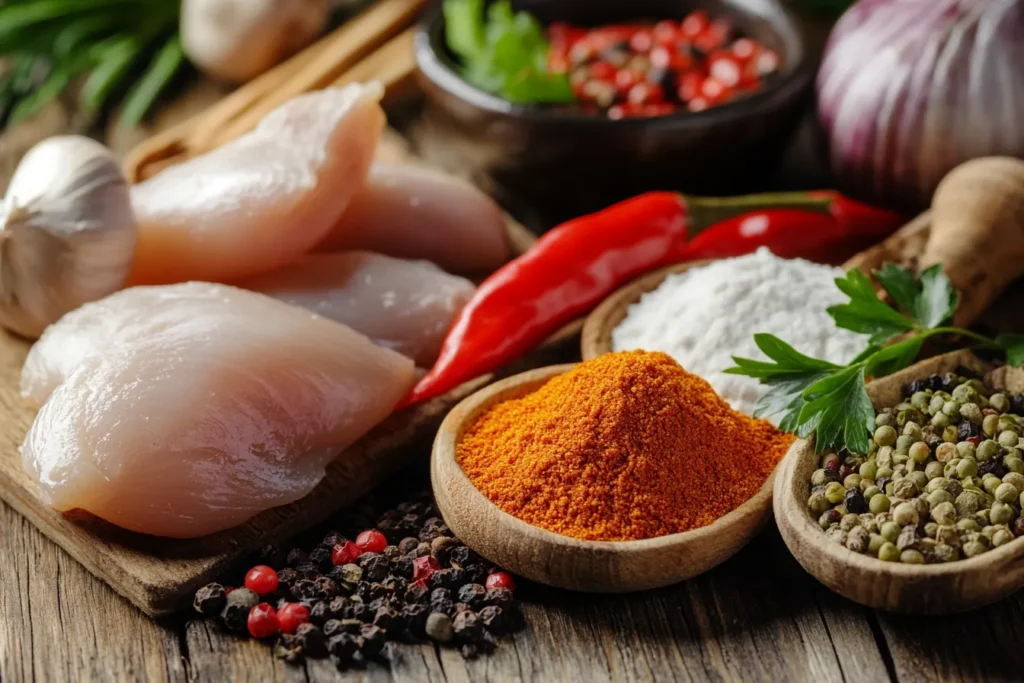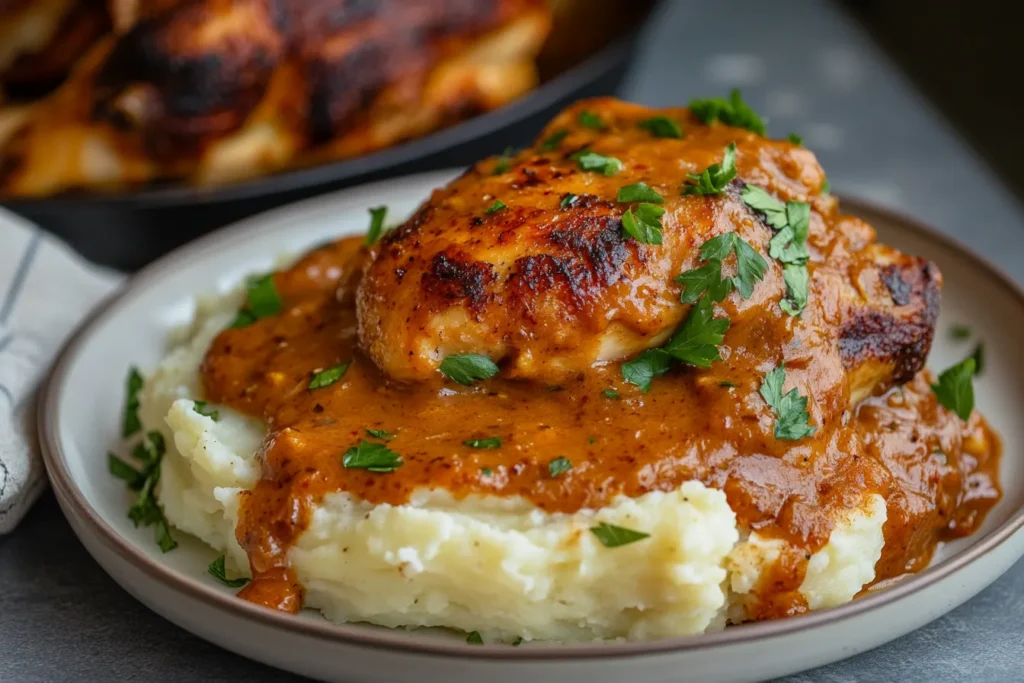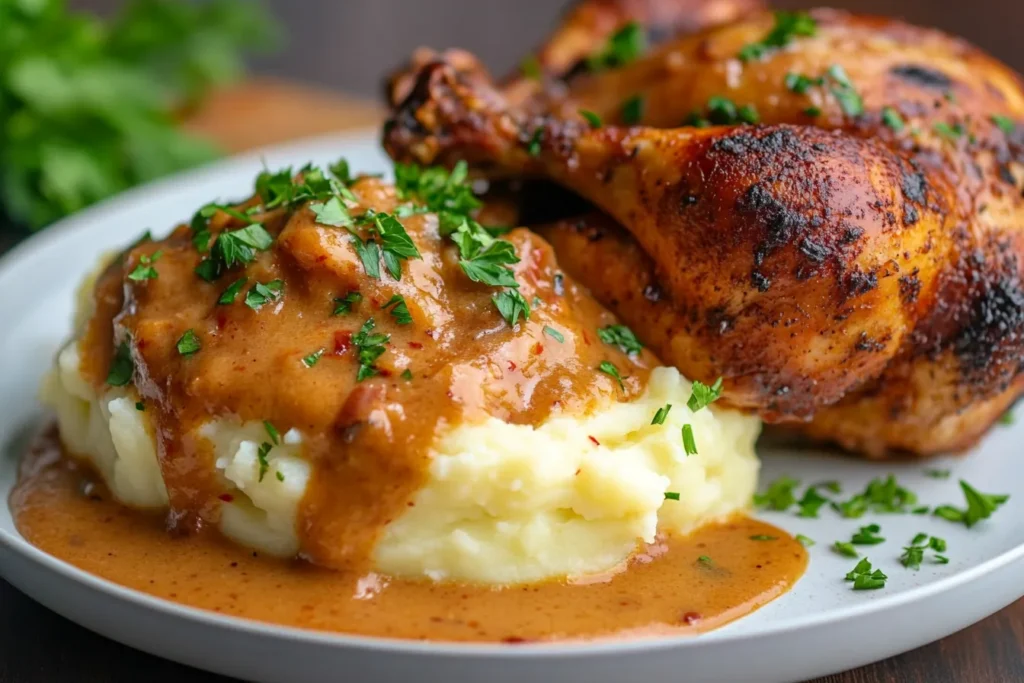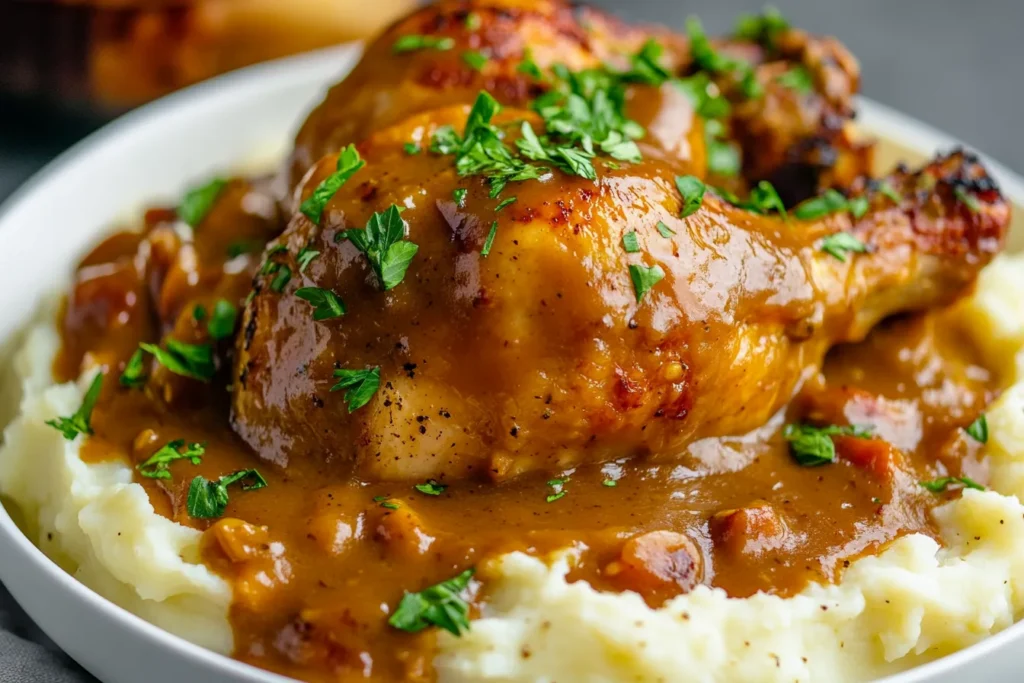Table of Contents
What is in chicken gravy mix? It’s a question many home cooks ask. The answer reveals the components behind that comforting, savory sauce. Chicken gravy mix provides a quick and easy way to enhance meals. This article will explore the ingredients, preparation, and secrets of crafting amazing chicken gravy.
Decoding Chicken Gravy Mix Ingredients

Chicken gravy mix simplifies gravy making. Most mixes contain a base of starch. This starch acts as a thickening agent. Flour, cornstarch, and modified food starch are common options. In addition to starch, mixes include dehydrated chicken flavorings. These flavorings often consist of chicken broth solids, chicken fat, and seasonings. Salt is a crucial component, enhancing overall taste.
Common Components
Most chicken gravy mixes have similar ingredients. They all aim to replicate homemade gravy. Dehydrated chicken broth is a key element. This broth gives the gravy its signature chicken flavor. Vegetable oils or rendered chicken fat add richness. Spices like pepper, garlic powder, and onion powder enhance the flavor profile (What is in chicken gravy mix?).
Variations in Mixes
Not all chicken gravy mixes are created equal. Some include artificial flavors or colors. Others boast all-natural ingredients. Examining the ingredient list helps determine quality. Health-conscious cooks should opt for low-sodium options. Organic mixes provide a chemical-free choice (What is in chicken gravy mix?).
The Incredible Process of Making Chicken Gravy
Making chicken gravy from a mix is incredibly simple. The basic process involves combining the mix with water. Some recipes call for milk or broth for extra richness. The mixture is then cooked over heat, stirring constantly. The starch thickens the liquid, creating a smooth gravy.
Step-by-Step Guide
First, whisk the gravy mix with cold water in a saucepan. Using cold water prevents clumping. Second, bring the mixture to a boil over medium heat. Third, reduce the heat and simmer for a few minutes. The gravy should thicken during this time. Remember to stir constantly to avoid scorching (What is in chicken gravy mix?).
Tips for Perfect Gravy
Achieving perfect gravy requires attention to detail. Whisk the mix thoroughly to eliminate lumps. Use a whisk for a smooth consistency. Adjust the liquid ratio to achieve your desired thickness. Add a pat of butter at the end for extra sheen (What is in chicken gravy mix?).
What is in Chicken Gravy Mix? Flavor Enhancers
What is in chicken gravy mix that makes it so flavorful? Seasonings play a vital role. Salt is a basic but essential component. Pepper adds a touch of spice. Garlic powder and onion powder create depth of flavor. Some mixes also contain herbs like thyme or rosemary. These additions elevate the taste.
Seasoning Secrets
Enhancing gravy flavor involves more than just the mix. Adding fresh herbs can make a big difference. A sprig of rosemary or thyme adds a subtle earthiness. A dash of Worcestershire sauce provides umami. A squeeze of lemon juice brightens the flavor (What is in chicken gravy mix?).
Avoiding Common Mistakes
Over-salting is a common gravy mistake. Taste the gravy before adding more salt. Scorching the gravy can also ruin its flavor. Stir constantly and use low heat. Clumping is another potential issue. Whisk the mix with cold water before heating (What is in chicken gravy mix?).
Amazing Ways to Use Chicken Gravy

Chicken gravy is incredibly versatile. It complements various dishes. Mashed potatoes and gravy are a classic pairing. It also tastes amazing on biscuits or fried chicken. Chicken gravy enhances roast chicken and meatloaf (What is in chicken gravy mix?).
Classic Pairings
Mashed potatoes and chicken gravy are a comfort food staple. The creamy potatoes and savory gravy create a satisfying meal. Biscuits and gravy are another popular combination. The fluffy biscuits soak up the rich gravy. Fried chicken with gravy is a Southern favorite.
Creative Applications
Chicken gravy can be used in more creative ways. Pour it over rice or noodles for a quick meal. Use it as a sauce for chicken pot pie. Drizzle it over roasted vegetables. It adds flavor and moisture to any dish. Gravy can even be used as a base for soups and stews.
Essential Storage and Safety Tips
Proper storage is crucial for leftover chicken gravy. Store it in an airtight container in the refrigerator. Consume within three to four days. Reheating gravy safely is also important. Ensure it reaches an internal temperature of 165°F.
Refrigeration Guidelines
Cool the gravy completely before refrigerating. This prevents condensation. Use a shallow container for quicker cooling. Label the container with the date. This helps track freshness. Never leave gravy at room temperature for more than two hours (What is in chicken gravy mix?).
Reheating Methods
Reheat gravy in a saucepan over low heat. Stir frequently to prevent scorching. Add a little water or broth if it’s too thick. Microwave reheating is also an option. Heat in short intervals, stirring in between. This ensures even heating (What is in chicken gravy mix?).
The Secret to Perfect Consistency
Achieving the perfect gravy consistency is key. Too thin and it’s watery. Too thick and it’s gloopy. The right ratio of mix to liquid is essential. Constant stirring helps prevent lumps.
Troubleshooting Thickness
If the gravy is too thin, add more gravy mix. Whisk it with a small amount of cold water first. Then, stir it into the simmering gravy. If the gravy is too thick, add more liquid. Water, broth, or milk work well. Add a little at a time until you reach the desired consistency (What is in chicken gravy mix?).
Avoiding Lumps
Lumps are a common gravy problem. Prevent them by whisking the mix with cold water. Add the mixture to the saucepan slowly. Stir constantly while heating. If lumps do form, use an immersion blender to smooth the gravy (What is in chicken gravy mix?).
What is in Chicken Gravy Mix? Exploring Healthier Options
What is in chicken gravy mix that contributes to its nutritional profile? Many commercial mixes are high in sodium and fat. However, healthier options are available. Low-sodium mixes and organic options provide a healthier alternative. You can also make your own gravy from scratch. This allows you to control the ingredients (What is in chicken gravy mix?).
Low-Sodium Alternatives
Excessive sodium is a concern for many. Opt for low-sodium gravy mixes. Check the nutrition label carefully. Look for mixes with less than 400mg of sodium per serving. You can also reduce the sodium by using unsalted broth.
Homemade Options
Making gravy from scratch gives you complete control. Use chicken broth, flour, and seasonings. Simmer the mixture until thickened. Add a touch of cream for richness. Homemade gravy is often lower in sodium and additives (What is in chicken gravy mix?).
Exploring Gluten-Free Chicken Gravy Mix Options

For those with gluten sensitivities, finding suitable chicken gravy can be challenging. Traditional gravy often uses wheat flour as a thickener. However, gluten-free alternatives exist. Cornstarch, tapioca starch, and rice flour are excellent substitutes. Many brands now offer specifically labeled gluten-free chicken gravy mixes.
Identifying Gluten-Free Mixes
Reading labels carefully is crucial. Look for certifications like the “Certified Gluten-Free” symbol. Inspect the ingredient list for wheat, barley, or rye. If uncertain, contact the manufacturer. Online resources also provide lists of gluten-free products.
Gluten-Free Thickening Agents
When making gravy from scratch, choosing the right thickener is essential. Cornstarch is a popular choice. Tapioca starch provides a smooth, glossy finish. Rice flour adds a slightly nutty flavor. Experiment to find your preferred texture and taste. Always whisk the starch with cold water before adding it to hot liquids.
The Dangerous Additives to Watch Out For
While convenient, some chicken gravy mixes contain undesirable additives. Artificial flavors, colors, and preservatives can raise health concerns. Monosodium glutamate (MSG) is a common flavor enhancer that some people are sensitive to. Hydrogenated oils contribute unhealthy trans fats. Reading the ingredient list helps avoid these potential dangers.
Identifying Harmful Additives
Learn to recognize common harmful additives. Artificial colors are often listed as FD&C Blue #1, Yellow #5, or Red #40. Artificial flavors are often vague and undefined. Preservatives like BHT and TBHQ may have negative health effects (What is in chicken gravy mix?).
Natural and Organic Alternatives
Opt for natural and organic chicken gravy mixes whenever possible. These options typically avoid artificial additives and preservatives. They often use real chicken broth and natural seasonings. While they may be more expensive, the health benefits are worth it. Consider making your own gravy from scratch to have complete control over the ingredients.
FAQ
chicken and gravy recipe
A simple chicken and gravy recipe involves browning chicken pieces, then simmering them in a mixture of chicken broth, herbs, and a thickening agent like flour or cornstarch. Cook until the chicken is cooked through and the gravy has thickened to your liking.
How can I make chicken gravy taste better?
To enhance chicken gravy flavor, consider adding fresh herbs like thyme or rosemary, a splash of Worcestershire sauce for umami, or a squeeze of lemon juice for brightness. Browning the chicken or using pan drippings before making the gravy also adds depth.
What goes well with chicken and gravy?
Chicken and gravy pair wonderfully with mashed potatoes, rice, biscuits, and roasted vegetables like green beans, carrots, or peas. It’s also a great addition to chicken pot pie or served over stuffing.
How to make a good chicken gravy?
Start with a good base: either pan drippings from the chicken or a flavorful chicken broth. Use a whisk to incorporate a thickening agent (flour or cornstarch) smoothly. Simmer until thickened, stirring constantly. Season with salt, pepper, and herbs to taste. Adjust consistency with more broth if needed.

